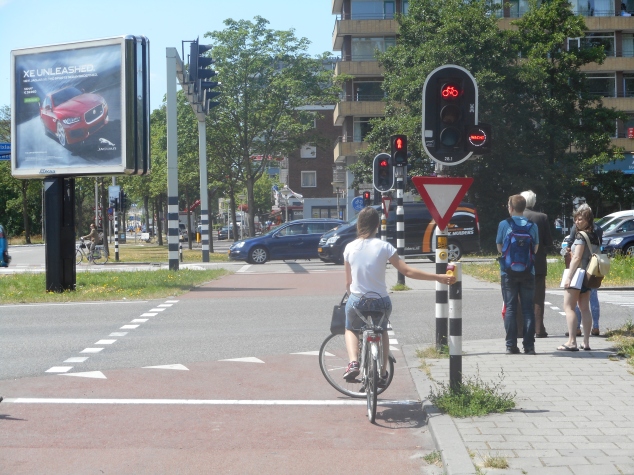During our first facility tour in Delft with a large group of students from Northeastern University, we visited a woonerf, protected intersection, single-lane roundabout, bicycle boulevard, and a two-way cycle track. A summary of all of these facilities can be found in the below map and on the Northeastern University blog.
I am going to focus on the protected intersection at Ruys de Beerenbrouckstraat and Princes Beatrixlaan and provide a comparison to the United States. The below photo shows a panorama I took of the protected intersection. Notice the use of the white shark teeth, which are yield markings. Unlike in the United States, it is very rare to find a stop sign in the Netherlands. Stop signs are reserved for crossings where people need to stop.
Even though it was a tough decision, I decided to focus on the protected intersection because four bike friendly cities in the United States are currently racing to install the first protected intersection in the United States. The article includes two great videos that explain what a protected intersection is. In case you have trouble opening the link, here is one of the videos.
In addition, the protected intersection in the Netherlands includes a wacht signal (wacht is Dutch for “wait”) that is integrated with the bike signal. Since signal time varies, the wacht signal can adjust the signal time to the actual amount of time that remains. This is one reason why the wacht signal does not use a number countdown system.
Even though more cyclists are usually waiting at stop lights in the Netherlands, I wanted to share the below photo to show you how cyclists in the Netherlands often make use of objects so they don’t have to dismount from their bike. Notice how the cyclist is holding onto the pole, which has a device installed to trigger the bike signal, so he doesn’t have to dismount from his bike. Also note the bicycle and pedestrian refuge island, which provides a safe location for cyclists and pedestrians to wait if they don’t make it all the way across the intersection.
According to Peter Koonce, who is a transportation engineer for the City of Portland (OR), Portland is the first city in the United States to install a wacht signal. Here is a video that explains how the wacht signal works in Portland. I hope more cities in the United States start using the wacht signal because they help cyclists know how long they actually have to wait for the signal to turn green and should encourage cyclists to stop running red lights. Even though I find it hard to believe since I often see cyclists run red lights in Portland, a study at Portland State University found that 94% of cyclists in Portland wait at red lights. With the installation of wacht signals, more cyclists may be willing to wait at red lights.




Excellent posts Ray. If you have a minute, take a look at whether the U.S. designed protected intersections that you have seen designs of incorporate the Dutch standards that you have seen in class.
Thanks for the feedback! As you pointed out in class, the Salt Lake City protected intersection will not have a separated bike signal, which is a Dutch standard, so cyclists may be hit by right turning traffic from the travel lane. Since protected intersections are new in the United States, hopefully preventable safety concerns like this won’t halt future protected intersections from being built.